电子信息类专业英语 第2章
电子信息科学专业英语En_unit2
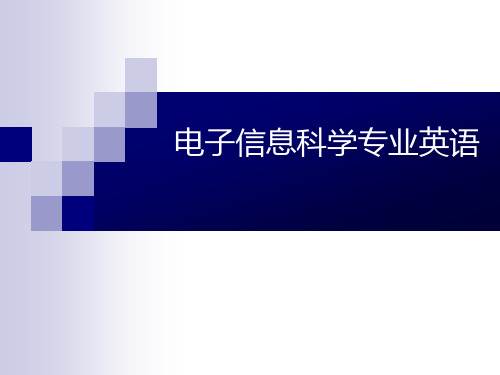
The earliest field-programmable arrays required several seconds or more to change their connections—perfectly suitable for engineers who wanted to test alternative circuit designs or for companies that sold devices that might need occasional upgrading.
目前在计算领域所采用的大多数硬件中,门电路的逻辑功 能是固定不变、不能被修改的。
In FPGAs, however, both the logic functions performed within the logic blocks and the connections between the blocks can be altered by sending signals to the chip.
general purpose: programming instructions encoded in
binary format can lead a microprocessor through virtually
any logical or mathematical operation a programmer can conceive.[1]
像常用于个人电脑的英特尔奔腾(Intel Pentium)芯片和 摩托罗拉Power PC这些芯片,都是通用微处理器芯片:使 用二进制格式编码的程序指令,可真正实现程序员所设计 的任何逻辑和数学的运算。
电子信息科学技术专业《专业英语》教学大纲(新)

《专业英语》教学大纲English for Electronic Information Science and Technology学 时:32学 分:2 制订者:陈青春审核者:鲁植雄一、课程性质本课程为电子信息科学与技术专业科类选修课,授课对象为电子信息科学与技术专业高年级学生,宜安排在三年级进行。
二、教学目的与要求通过本课程学习,掌握电子信息科学与技术的英语表达方式和常用词汇,提高本专业英语原文文献的阅读能力。
三、教学内容及安排(一)课堂讲授部分(32学时)内 容学时 Course introduction 2 Unit 1 Electronic devices 3 Unit 2 Electronic circuits3 Unit 3 Electronic system components 3 Unit4 Electronic system 3 Unit5 Modern digital design 3 Unit6 Digital signal processing 3 Unit7 Audio and voice 3 Unit8 Image and video 3 Unit9 Embedded applications3 Unit 10 Electronic instruments and measurements3(二)实验部分(0学时)四、考核方式及成绩评定考核方式:开卷考试,120分钟,百分制成绩评定:平时成绩(作业、考勤、答疑)占总成绩30%; 期终考试占总成绩70%五、教材与参考书(一)教材1.任治刚编,《电子信息工程专业英语》,2004年,电子工业出版社,第一版(二)参考书1.李白萍编,《电子信息类专业英语》,2004年,西安电子科技大学出版社,第一版。
u04p2_Satellite-Based Mobile Communications_基于卫星的移动通信_20080508

《电子信息工程专业英语教程》(第二版)任治刚主编电子工业出版社感谢使用本书!请将发现的问题或者对本书的建议发送到rzgteaching@或与本书责任编辑联系。
1基于卫星的移动通信移动卫星通信开始于1976年由COMSAT发射的MARISA卫星,它为海上船只提供通信服务。
之后,国际海上卫星组织1(INMARSAT,the International Maritime Satellite Organization )于1979年成立。
目前,该组织向航空器和陆基终端(land-based terminals)提供移动卫星通信服务。
在美国、加拿大、澳大利亚和日本,已经有几个移动卫星通信系统提供着国内通信服务,而更多的移动卫星通信系统也在筹划中。
陆地移动通信系统引人注目的发展推动了利用低轨、中轨和同步轨道移动卫星通信系统实现全球移动通信的努力。
迄今为止,第二代陆地移动通信系统和卫星移动通信系统是独立存在的两个系统。
然而,这两个独立的系统正在组合起来形成第三代全球移动通信系统;在这个系统中,陆地移动通信系统和卫星移动通信系统不再扮演独立的角色,而是互补形成统一的系统。
卫星通信简史1945年,在一篇发表在《无线世界》(Wireless World)的文章里,Arthur C. Clarke提出了以下设想:把卫星发射到地球同步轨道上,这样三颗等距(equally spaced)卫星就能覆盖整个世界范围。
1957年,苏联才发射了第一颗卫星(Sputnik I),1958年初美军也发射了一颗卫星(Explore I),这两颗卫星传递的都是遥测信息。
1958年,美国空军发射了第一颗通信卫星SCORE (the Signal Communicating Orbit Repeater Experiment)。
SCORE是一颗延迟转发式(delayed-repeater)卫星,它接收来自地球的150MHz信号,储存在磁带上以备重新发射。
电子行业电子信息专业英语

电子行业电子信息专业英语1. IntroductionThe electronic industry plays a crucial role in the modern world, as it encompasses a wide range of products and services that rely on electronic components and systems. Within the electronic industry, the field of electronic information is particularly important. Electronic information professionals are responsible for the design, development, and maintenance of electronic systems that process and transmit information. In this document, we will explore the key concepts and terminology related to electronic information in the electronic industry.2. Fundamental Concepts2.1 Electronic InformationElectronic information refers to the data or signals that are processed, stored, and transmitted by electronic systems. It can includevarious forms of media, such as text, images, audio, and video. Electronic information systems are designed to convert, manipulate, and transmit this information in a reliable and efficient manner.2.2 Electronic ComponentsElectronic components are the building blocks of electronic information systems. They are devices that can control the flow of electrons in a circuit and perform various functions, such as amplification, signal processing, and data storage. Examples of electronic components include resistors, capacitors, transistors, and integrated circuits.2.3 Electronic SystemsElectronic systems are composed of multiple electronic components that work together to perform a specific function. They can range from simple systems, such as a basic calculator, to complex systems, such as a computer or a smartphone. Electronic systems often consist ofinterconnected circuits and subsystems that enable the processing and transmission of electronic information.3. Key Terminology3.1 Analog and Digital SignalsAnalog signals are continuous signals that can take on any value within a certain range. They are commonly used to represent real-world phenomena, such as sound and light. Digital signals, on the other hand, are discrete signals that can only take on specific values, typically represented as 0s and 1s. They are used in digital electronic systems to represent and process information.3.2 MicrocontrollersMicrocontrollers are small, self-contained computers that are used to control electronic systems. They are often embedded in electronic devices to perform specific tasks, such as reading sensor data,controlling actuators, and executing algorithms. Microcontrollers typically have a CPU, memory, and input/output interfaces.3.3 Wireless CommunicationWireless communication refers to the transmission of electronic information without the use of physical cables or wires. It relies on electromagnetic waves to carry signals between electronic devices. Wireless communication technologies, such as Wi-Fi and Bluetooth, are widely used in various applications, including mobile devices, home automation, and industrial control systems.3.4 Circuit DesignCircuit design involves the creation and optimization of electronic circuits that perform specific functions. It includes selecting and connecting electronic components, designing PCB layouts, and analyzing circuit performance. Circuit design is crucial for ensuring the proper functioning and reliability of electronic systems.4. ConclusionIn conclusion, electronic information is a vital aspect of the electronic industry. Understanding the fundamental concepts and key terminology related to electronic information is essential for professionals working in this field. By familiarizing themselves with these concepts and terminology, electronic information professionals can effectively design, develop, and maintain electronic systems that process and transmit information in a reliable and efficient manner.。
电子信息专业英语(第二版)课件:Auxiliary Storage
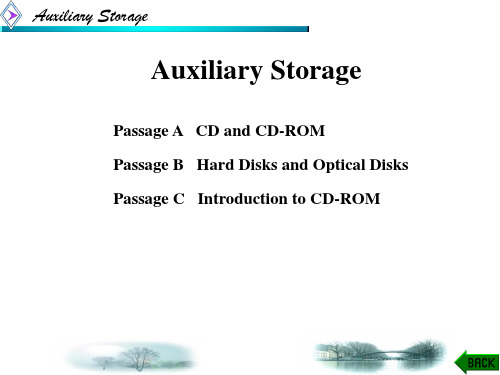
Auxiliary Storage
[2] The sampled digital values, along with error correction data, tracking codes, and cueing data, are recorded on a digital tape, which is used to make compression-molded plastic discs 12 cm (4.72 in) in diameter, each covered by a thin, reflective metallic layer and protected by a clear plastic coating.
Auxiliary Storage
Notes [1] Although it has been used primarily to record
stereophonic sound and has supplanted the long-playing PHONOGRAPH record as the principal medium for music
Auxiliary Storage
[3] Introduced in 1992, the Sony MiniDisc measures only 6.35 cm (2.5 in) in diameter, but it can be used to record as well as play up to 74 minutes of music.
Auxiliary Storage
Unlike the conventional phonograph record, the CD stores information in digital form. Stereophonic (two-channel) sound signals are digitally sampled at a rate of 44,100 times per second per channel. Each sample is expressed as a binary number value consisting of 16 binary digits, or bits. The sampled digital values, along with error correction data, tracking codes, and cueing data, are recorded on a digital tape, which is used to make compressionmolded plastic discs 12 cm (4.72 in) in diameter, each covered by a thin, reflective metallic layer and protected by a clear plastic coating.[2] During playback, a low-powered laser beam reads the digital data through the reflective rear surface of the disk.
【精品】电子信息工程专业英语课后答案

电子信息工程专业英语课后答案电子信息工程专业英语-教师用书Part 1第一课关于电子技术一、课文习题参考答案Ⅰ. (1) alternating current circuits (2) semiconductor diodes(3) passive component(4) the combinatory logic electric circuit(5) rectification(6) Laplace transform(7) inductor(8) Fourier series and Fourier transformⅡ.(1)控制理论(2)场效应管三极管(3)布尔代数(4)稳压(5)相关性和功率谱密度(6)滤波器类型(7)模/数转换器(8)时序逻辑电路的分析与综合Ⅲ.(1)Electronics is a part of the larger field of electricity. The basic principles of electricity are also common to electronics. Modern advances in the field of computer, control system, communications have a close relationship with electronics. The field of electronics includes the electron tube, transistor, integrated circuit and so on.(2) Direct current circuits & Alternating current circuits,Analog electronics,Digital electronics,signal and systems,Circuit theory and design, Control theory, Microcontrollersystems,Computer programming for engineering applications.(3) This curriculum mainly introduces the characteristics of semiconductor devices in linear application scope.The content involved in semiconductor diodes (PN junction diodes, special purpose diodes), transistors (field effects and bipolar transistors), signal amplifiers, practical amplifiers, biasing circuits, operationalamplifiers circuit and other circuits (rectification, regulation and DC power supplies).(4) This partial studies take the basicelectric circuit theory and the operational amplifier knowledge as the foundation. The main study goal is to enhance understanding of the electric circuit theory. Its main content includes the elementary theory in circuit theory (network functions, characteristic frequencies), types offilter (lowpass,bandpass), review of operational amplifiers (design of first and second order using operational amplifiers, cascade design), filter characteristics(Butterworth, Chebyshev, frequency transformations in design, sensitivity design of passive LC ladder filters and a brief introduction to switched capacitor filters).(5) Perfect.二、参考译文电子学的发展电子学是电学的一部分。
电子信息类专业英语(第二版)(李白萍)

On the contrary,TS-SCDMA adapts the uplink/downlink radio according ro the data load within a single unpaired frequency thus utilizing the spectrum more efficiently,and provides dara rates ranging form 12kbps to 2Mbps.
6.作为一种以同步模式运行的结合CDMA自适应技术的高级TDMA、TDD系统,TD-SCDMA具有对称电路交换服务业务(如语音和视频)和非对称组交换服务业务(如手机上网)。
Designed as an advanced TDMA,TDD system with an adaptive CDMA component operating in synchronous mode,TD-SCDMA masters both symmetric circuits switched services (such as speech or video)as well as asymmetric packet switched services(such mobile internet access).
The signal-processing block at the transmitter conditions the source for more efficient transmission.
5.此外信号处理器还可以给数码子加入奇偶校验位,即提供信道编码 ,使的接收机的信号处理器可以进行误码检测和纠错,以减少或消除由信道噪声所引起的误码。
电子信息工程专业英语 课文翻译 Unit 02 译文
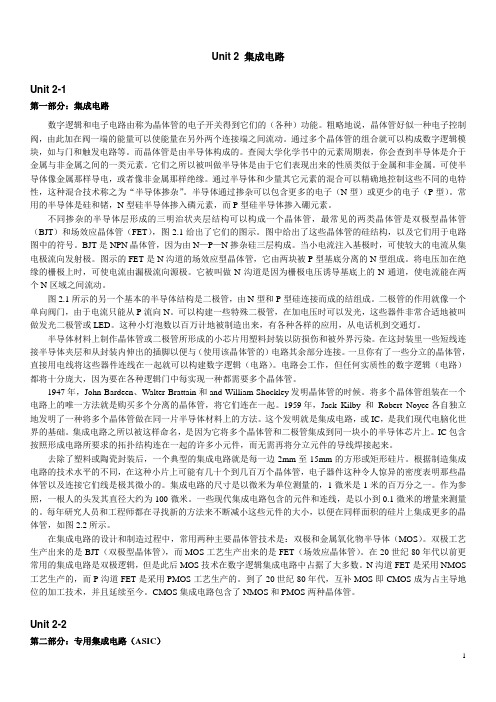
Unit 2 集成电路Unit 2-1第一部分:集成电路数字逻辑和电子电路由称为晶体管的电子开关得到它们的(各种)功能。
粗略地说,晶体管好似一种电子控制阀,由此加在阀一端的能量可以使能量在另外两个连接端之间流动。
通过多个晶体管的组合就可以构成数字逻辑模块,如与门和触发电路等。
而晶体管是由半导体构成的。
查阅大学化学书中的元素周期表,你会查到半导体是介于金属与非金属之间的一类元素。
它们之所以被叫做半导体是由于它们表现出来的性质类似于金属和非金属。
可使半导体像金属那样导电,或者像非金属那样绝缘。
通过半导体和少量其它元素的混合可以精确地控制这些不同的电特性,这种混合技术称之为“半导体掺杂”。
半导体通过掺杂可以包含更多的电子(N型)或更少的电子(P型)。
常用的半导体是硅和锗,N型硅半导体掺入磷元素,而P型硅半导体掺入硼元素。
不同掺杂的半导体层形成的三明治状夹层结构可以构成一个晶体管,最常见的两类晶体管是双极型晶体管(BJT)和场效应晶体管(FET),图2.1给出了它们的图示。
图中给出了这些晶体管的硅结构,以及它们用于电路图中的符号。
BJT是NPN晶体管,因为由N—P—N掺杂硅三层构成。
当小电流注入基极时,可使较大的电流从集电极流向发射极。
图示的FET是N沟道的场效应型晶体管,它由两块被P型基底分离的N型组成。
将电压加在绝缘的栅极上时,可使电流由漏极流向源极。
它被叫做N沟道是因为栅极电压诱导基底上的N通道,使电流能在两个N区域之间流动。
图2.1所示的另一个基本的半导体结构是二极管,由N型和P型硅连接而成的结组成。
二极管的作用就像一个单向阀门,由于电流只能从P流向N。
可以构建一些特殊二极管,在加电压时可以发光,这些器件非常合适地被叫做发光二极管或LED。
这种小灯泡数以百万计地被制造出来,有各种各样的应用,从电话机到交通灯。
半导体材料上制作晶体管或二极管所形成的小芯片用塑料封装以防损伤和被外界污染。
在这封装里一些短线连接半导体夹层和从封装内伸出的插脚以便与(使用该晶体管的)电路其余部分连接。
电子信息专业英语(第二版)课件:Telecommunications

The golden age of automatic telephony occurred after World WarⅡwhen the entire long-distance network was automated. The invention of the transistor spurred the application of electronics to switching systems and led to the deployment of the first electronic switching in the late 1950s. Electronic switching made it possible to design and build switches with greater capacity.
Satellite communication was first proposed in 1945 by the British science fiction writer, Arthur C. Clarke. Satellite communications became a reality with the launching of the Russian satellite Sputnik (in 1957) and the American satellite Explorer (in 1958). The AT&T Telstar was the first experimental satellite capable of relaying television (TV) programs across the Atlantic Ocean. It was launched from Cape Canaveral(now Cape Kennedy)on July 1962. The first global civil communications satellite, INTELSAT Ⅰ(Early Bird), was launched in April 1965.
电子信息专业英语(第二版)课件:科技英语基础知识(二)
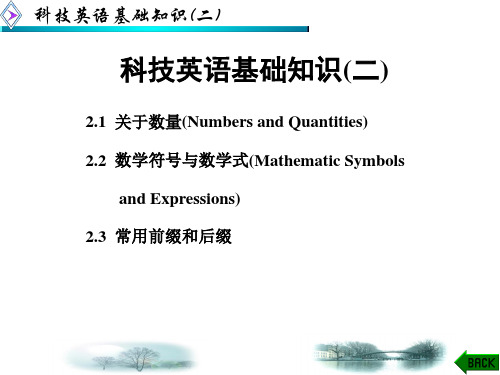
dis- 不, 除: disadvantage
jet:
jet plane
喷气式飞机
plant:
power plant
电厂
driver:
screw driver
螺丝刀
科技英语基础知识(二)
2) 合成法
有不少英语单词里由两个或三个以上单词组成, 有直接
结合和连符结合两种方式。
(1) 直接结合。
① 结合成名词。例如:
n.+n. textbook
教科书
科技英语基础知识(二)
(2) The switching time of the new type transistor is shortened by a factor of three.
译文1: 新型晶体管的开关时间缩短了2/3。 译文2: 新型晶体管的开关时间缩短为1/3。 为避免引起歧义, 关于减小的翻译最好不译成减小多少 倍, 而译成分数或百分数。按减小净量来翻译, 则遵循(n-1)/n 的规则(如译文1)。若按减小后的余量翻译, 则为1/n(如译文2)。
科技英语基础知识(二)
(3) The cost of TV sets was reduced by 70%. 电视机的成本降低了70%。 (4) We have radio experiments every three weeks. 我们每三周(每隔二周)做一次无线电实验。 every按“每隔”来翻译时, 须遵循(n-1)规则。
昼夜(服务) 难通行的(路) 过时的 中小型 往复(运动) 上下行(交通)
科技英语基础知识(二)
3) 加缀法
一般, 前缀并不改变词的词类, 但赋予词以新的含义, 因
为前缀本身是有含义的; 而后缀一般不改变词的基本含义, 但
经典:信息科学与电子工程专业英语-unit-2

8
2
A transistor is constructed by creating a sandwich of differently doped semiconductor layers. The two most common types of transistors, the bipolar-junction transistor (BJT) and the field-effect transistor (FET) are schematically illustrated in Figure 2.1.
将电压加在绝缘的栅极上时, 可使电流由漏极流向源极。
因为栅极电压诱导基底上的N通道, 使电流能在两个N区域之间流动。
11
3
Another basic semiconductor structure shown in Figure 2.1 is a diode, which is formed simply by a junction of N-type and Ptype silicon. Diodes act like one-way valves by conducting current only from P to N.
半导体材料上制作晶体管或二极管 所形成的小芯片用塑料封装以防损 伤和被外界污染。
14
4
Small wires are connected within this package between the semiconductor sandwich and pins that protrude from the package to make electrical contact with other parts of the intended circuit.
《电子信息工程专业英语》课程教学大纲

《专业英语》课程教学大纲(执笔人:潘玉竹审核人:教学院长:一、课程简介(一)课程代码:0442531(二)课程名称:(电子信息工程)专业英语Specific English for Electronic Information Engineering (三)修读对象:电子信息工程(三)总学时与学分:36学时理论2学分(四)考核方式:考试(五)相关课程:低频电子线路,高频电子线路,信号与系统,数字电路,数字信号处理等(六)内容提要:书中包括元器件、传感器、信号调理、数字信号处理、嵌入式系统等内容。
各章节间相互独立。
二、教学目的和教学方法1、教学目的本门课程按照专业特点编写,学习相关的专业知识同时学习英语。
注重专业知识理解与英语理解翻译能力。
2、教学方法主要采用课堂教学,重点要加强随堂翻译,以提高学生的专业知识理解与英语理解翻译能力。
三、理论与实验教学学时分配四、选用教材和主要教学参考书教材选《电子信息工程专业英语》曹玲芝等编著华中科技大学出版社参考书:(1)Curtis D.Johnson Process Control Instrumentation Technology 北京科学技术出版(2)刘剑.《电气工程及自动化专业英语》北京,中国电力出版社;(3).au(4)heet:///components五、理论教学内容第一章 Electric Devices 8学时1.主要内容:Resistor/ Capacitor/ Inductor/Diode/ Transistor2.基本要求:掌握电阻,了解并能翻译其他元件资料。
随堂翻译。
第二章 Temperature Sensors 6学时1.Resistor-Temperature Detectors/ Thermistors/ Thermocouples2.基本要求: 以温度传感器为主学习,了解后两种。
随堂翻译。
第三章 Data Acquisition Systems 8 学时1.主要内容 : Analog Signal Conditioning/Digital Signal Conditioning/ Structure of DataAcquisition Systems2. 基本要求:学习模拟信号调节与数据接受系统。
电子信息工程专业英语
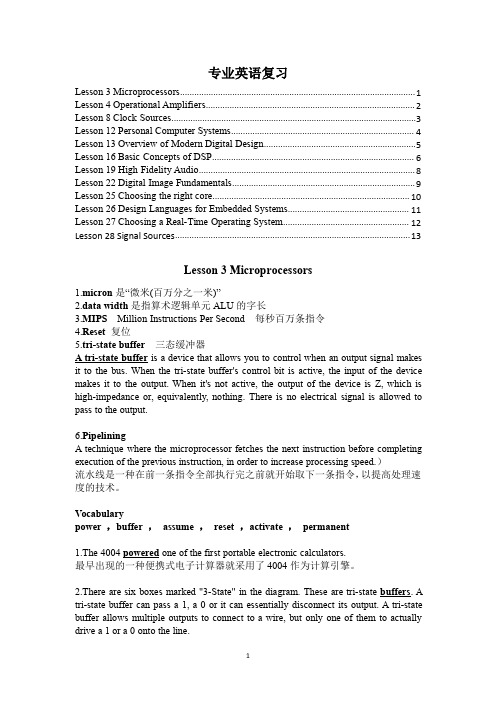
专业英语复习Lesson3Microprocessors (1)Lesson4Operational Amplifiers (2)Lesson8Clock Sources (3)Lesson12Personal Computer Systems (4)Lesson13Overview of Modern Digital Design (5)Lesson16Basic Concepts of DSP (6)Lesson19High Fidelity Audio (8)Lesson22Digital Image Fundamentals (9)Lesson25Choosing the right core (10)Lesson26Design Languages for Embedded Systems (11)Lesson27Choosing a Real-Time Operating System (12)Lesson28Signal Sources (13)Lesson3Microprocessors1.micron是“微米(百万分之一米)”2.data width是指算术逻辑单元ALU的字长3.MIPS Million Instructions Per Second每秒百万条指令4.Reset复位5.tri-state buffer三态缓冲器A tri-state buffer is a device that allows you to control when an output signal makes it to the bus.When the tri-state buffer's control bit is active,the input of the device makes it to the output.When it's not active,the output of the device is Z,which is high-impedance or,equivalently,nothing.There is no electrical signal is allowed to pass to the output.6.PipeliningA technique where the microprocessor fetches the next instruction before completing execution of the previous instruction,in order to increase processing speed.)流水线是一种在前一条指令全部执行完之前就开始取下一条指令,以提高处理速度的技术。
电子信息工程专业英语教程课后练习题含答案
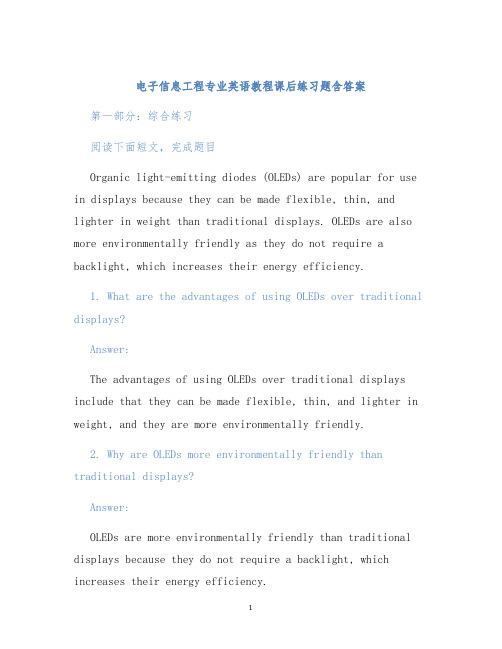
电子信息工程专业英语教程课后练习题含答案第一部分:综合练习阅读下面短文,完成题目Organic light-emitting diodes (OLEDs) are popular for use in displays because they can be made flexible, thin, and lighter in weight than traditional displays. OLEDs are also more environmentally friendly as they do not require a backlight, which increases their energy efficiency.1. What are the advantages of using OLEDs over traditional displays?Answer:The advantages of using OLEDs over traditional displays include that they can be made flexible, thin, and lighter in weight, and they are more environmentally friendly.2. Why are OLEDs more environmentally friendly than traditional displays?Answer:OLEDs are more environmentally friendly than traditional displays because they do not require a backlight, which increases their energy efficiency.完成下面句子,使其意思与原文相同1. The growth of social media platforms has led to an increase in cyberbullying.Answer:An increase in cyberbullying has been caused by the growth of social media platforms.2. The researchers found that there was a significant difference between the two groups.Answer:A significant difference between the two groups was found by the researchers.第二部分:专业术语练习选择最恰当的词汇,完成下面句子1. _______ is a circuit that can perform a single operation.A. DecoderB. EncoderC. Flip-flopD. GateAnswer:D. GateExplanation:A gate is a circuit that performs a single operation, such as AND, OR, or NOT.2. _______ refers to the process of converting an analog signal into digital form.A. SynthesisB. ModulationC. SamplingD. QuantizationAnswer:C. SamplingExplanation:Sampling refers to the process of converting an analog signal into digital form, where the value of the signal is sampled at regular intervals.根据定义给出对应术语1. The study of electronic devices and circuits.Answer:Electronics2. A device that supports the transfer of data between different networks.Answer:Gateway第三部分:阅读理解请阅读下面短文,并根据所提出的问题选择正确的答案。
- 1、下载文档前请自行甄别文档内容的完整性,平台不提供额外的编辑、内容补充、找答案等附加服务。
- 2、"仅部分预览"的文档,不可在线预览部分如存在完整性等问题,可反馈申请退款(可完整预览的文档不适用该条件!)。
- 3、如文档侵犯您的权益,请联系客服反馈,我们会尽快为您处理(人工客服工作时间:9:00-18:30)。
television (TV) programs across the Atlantic Ocean. It was launched
from Cape Canaveral(now Cape Kennedy)on July 1962. The first global civil communications satellite, INTELSAT Ⅰ(Early Bird), was
circuit called a marker, which provided common control of number
entry and line selection for all calls.[2]
Unit Two
Telecommunications
The golden age of automatic telephony occurred after World WarⅡwhen the entire long-distance network was automated. The invention of the transistor spurred the application of electronics to switching systems and led to the deployment of the first electronic
(QAM) methods were widely used as the modulation scheme for
digital radio-relay systems.
Unit Two
Telecommunications
The second phase of networking, which occurred in the 1960s,
(4 kHz bandwidth) is 64 kbps.[3] During the 1960s and 1970s, a
hierarchy of digital transmission channels based on the 64 kbps channel was established and still forms the backbone of today’s digital network. One of the popular digital transmission systems is called the T1 carrier, which supports 24 voice channels, each 64 kbps, resulting in a total of 1.544 Mbps.
networks and packet switching technology. The concept of packet switching was first published in a 1964 report by Paul Baran of the
Rand Corporation for the U.S. Air Force. In 1966, under the
D.C. to his colleague Alfred Vail in Baltimore, Maryland. Shortly after the invention of the telephone by Alexander Grahan Bell in 1876, it was realized that telephone wires had to converge on central points where telephone-to-telephone connections could be made.[1] These points were
was possible by extending high-frequency (HF) communication technology into the very-high-frequency (VHF) range. During World WarⅡ, the operating frequency bands of the analog radio-relay systems were extended into the ultra-high-frequency (UHF) range. The first link with over 100 repeater stations was placed into commercial service in 1951 between New York and San Francisco, operating in the 4 GHz band with a 20 MHz band. This was followed
launched in April 1965.
Unit Two
Telecommunications
The third phase of the evolution of communication networks
occurred in the 1970s and is characterized by the introduction of data
sponsorship of the Advanced Research Project Agency (ARPA) of the U.S. Department of Defense (DoD), an experimental packet-switching
by a growth of medium and high- capacity analog radio-relay systems
worldwide. By the early 1970s, digital microwave radio had gained importance and, by the 1980s, quadrature amplitude modulation
B.Strowger invented the first two-motion step-by-step switch. In a
step-by-step switch, a call was established and routed in a set of
progressive electromechanical steps, each under the direct control of the user’s dialing pulses. It remained as the workhorse of central office
Unit Two Telecommunications Passage A Evolution of Telecommunication Networks
The first phase in the evolution of communication networks is
dominated by the wide spread of telephony and covers over 90 years.
manual switch-boards, staffed by operators. This was followed by the
introduction of electromechanical switching and in 1889, Almond
Unit Two
Telecommunications
Unitns
The principle of converting analog signals to digital signals
became popular with the introduction of pulse code modulation (PCM); consequently, the known rate for telephone-quality speech
However, the telegraph preceded the telephone by more than 30 years and the teletypewriter by half a century. In 1844, Samuel Morse, the
telegraph’s inventor, sent the first telegraph message from Washington
Unit Two
Telecommunications
Satellite communication was first proposed in 1945 by the British science fiction writer, Arthur C. Clarke. Satellite communications became a reality with the launching of the Russian satellite Sputnik (in 1957) and the American satellite Explorer (in 1958). The AT&T Telstar was the first experimental satellite capable of relaying
